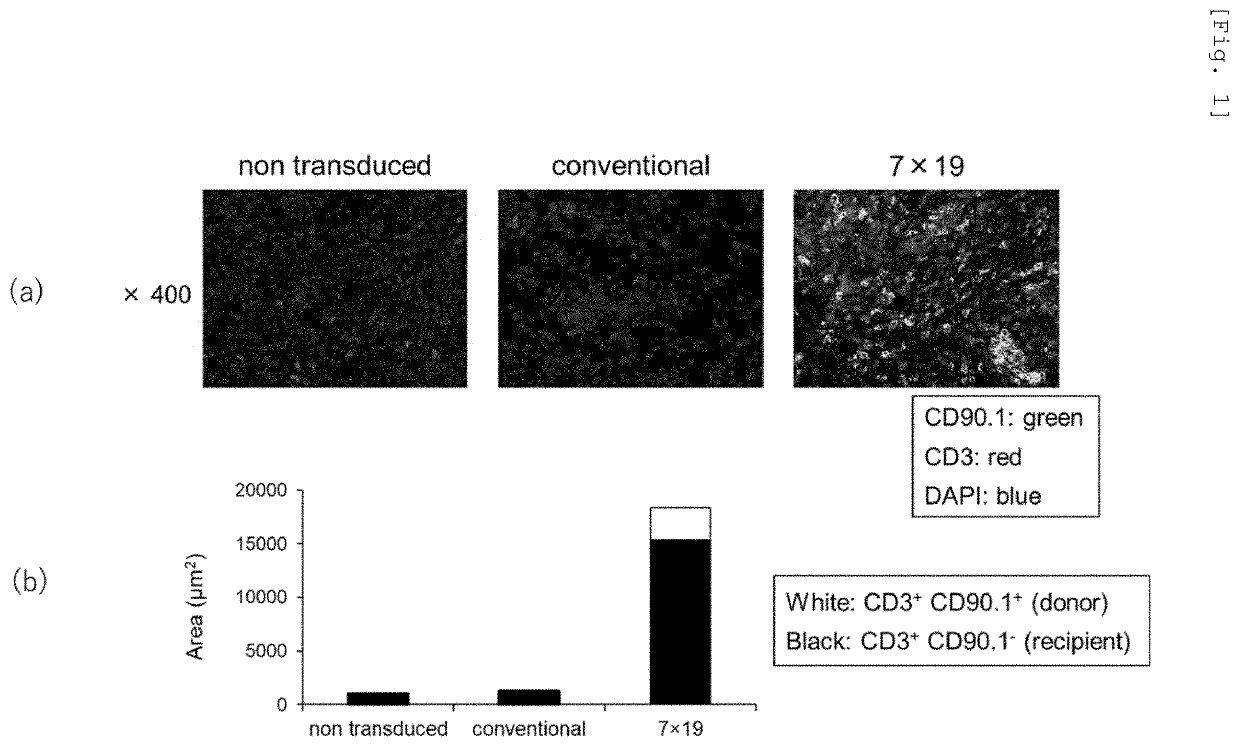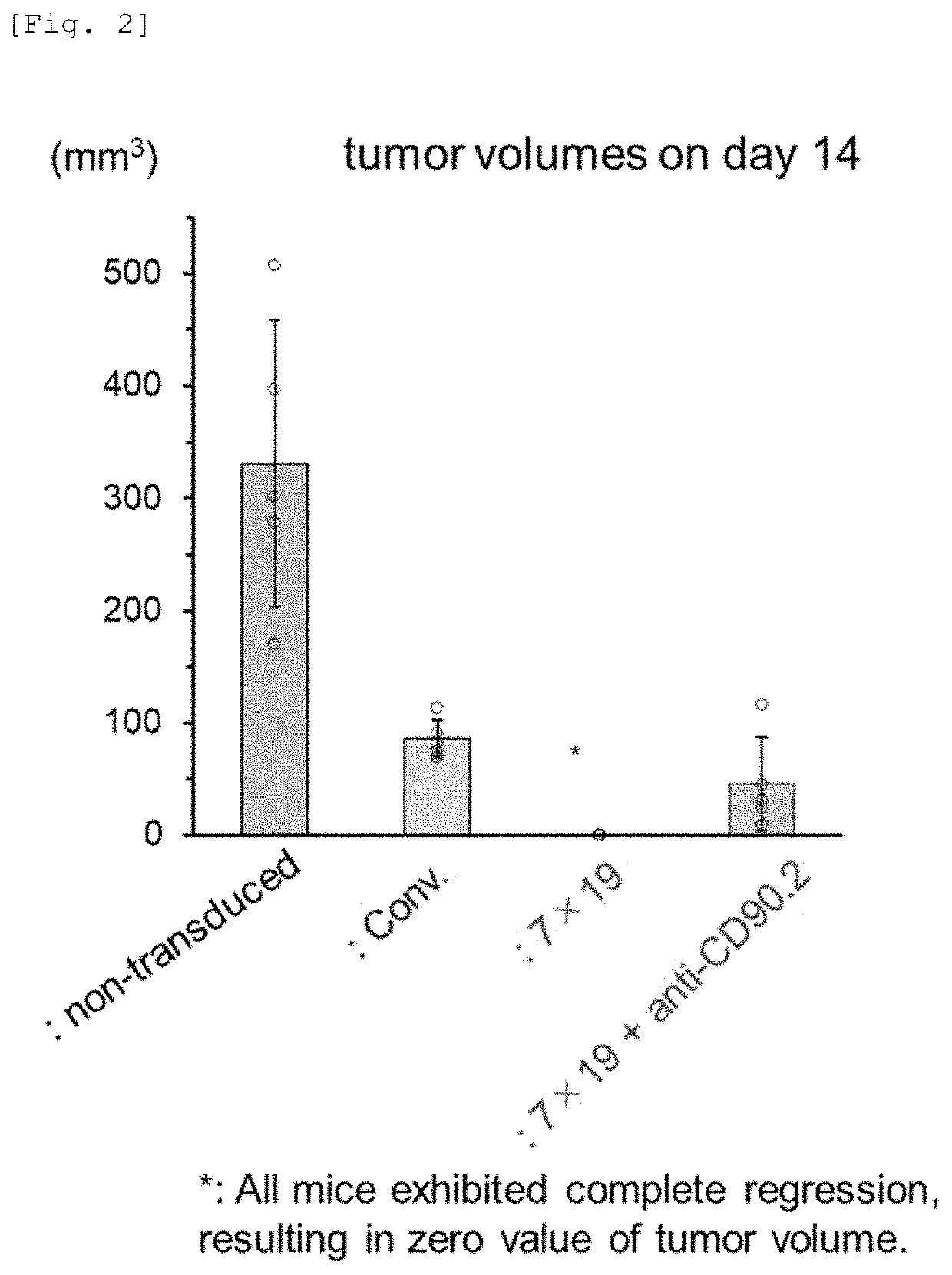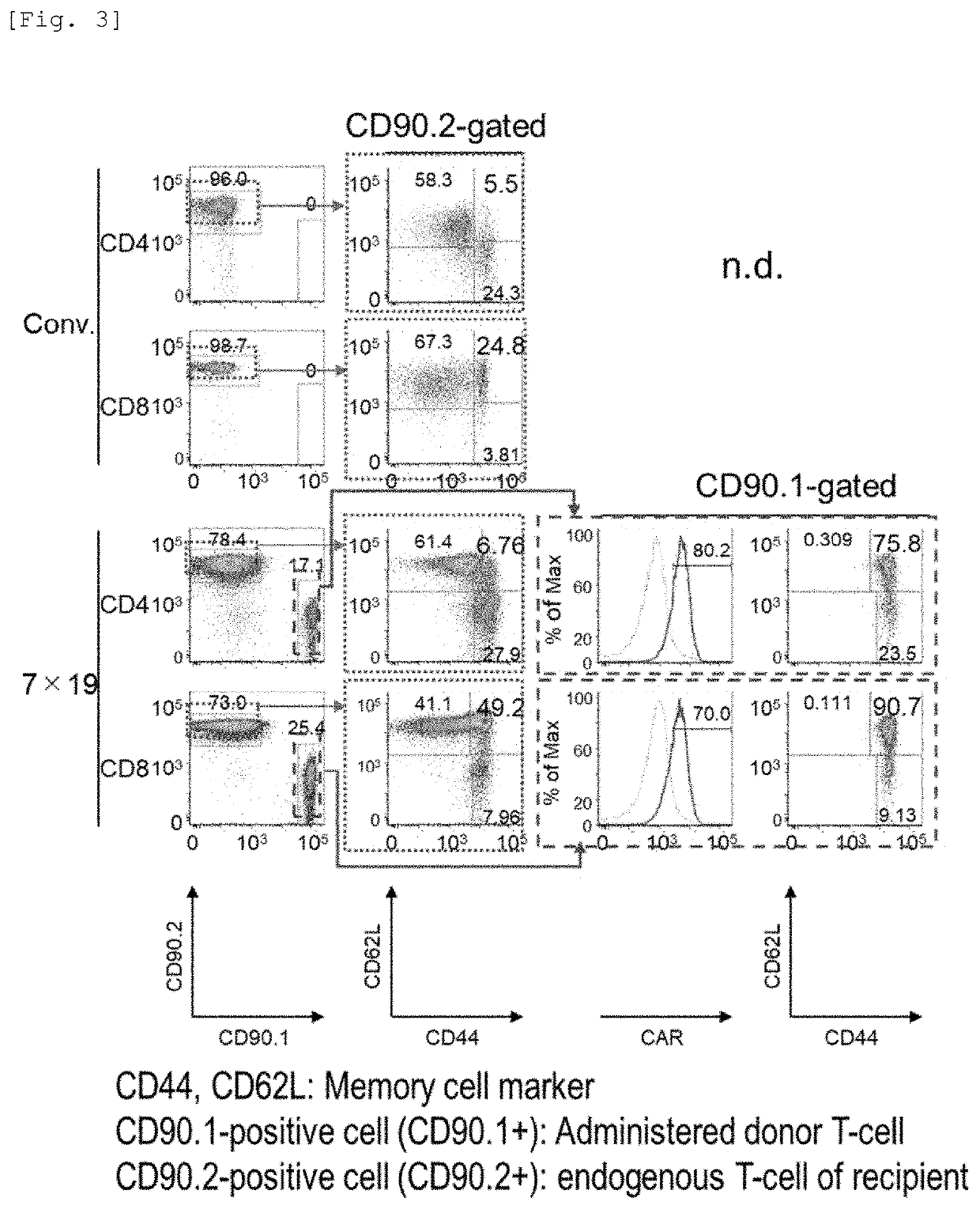Enhancer for t-cells or b-cells having memory function, malignant tumor recurrence inhibitor, and inducer for inducing memory function in t-cells or b-cells
a memory function and t-cell technology, applied in the field of t-cells or b-cells, can solve the problems of unrecognized preventive measures against recurrence and malignant tumors, and achieve the effect of inhibiting recurren
- Summary
- Abstract
- Description
- Claims
- Application Information
AI Technical Summary
Benefits of technology
Problems solved by technology
Method used
Image
Examples
example 1
[0092]In order to examine the antitumor effect of the CAR-IL-7 / CCL19-expressing T-cells, whether host (recipient)-derived endogenous T-cells would infiltrate tumor tissues, as in administered donor T-cells, was examined. First, 2.5×106 cells of 3LL-hCD20 (mouse lung cancer-derived cells 3LL allowed to express human CD20 by gene recombination) were subcutaneously inoculated to each of 7- to 10-week-old C57BL / 6 mice (manufactured by Japan SLC, Inc.) (day 0). Then, on day 7, an anticancer agent cyclophosphamide (CPA; 100 mg / kg) was intraperitoneally administered thereto. On day 10, 1×106 anti-human CD20 CAR-expressing T-cells or anti-human CD20 CAR-IL-7 / CCL19-expressing T-cells produced from the CD90.1-positive (CD90.1+) and CD90.2-negative (CD90.2−) congenic mice, or separated mouse T-cells without gene introduction as described above were intravenously administered thereto. On day 19, tumor tissues were excised from the mice. A biotin-labeled anti-CD90.1 antibody (clone OX-7 manufact...
example 2
[0094]2.5×106 cells of 3LL-hCD20 were subcutaneously inoculated to each of C57BL / 6 mice (day 0). Then, on day 3, 1×106 anti-human CD20 CAR-expressing T-cells (Conventional: Conv.) or anti-human CD20 CAR-IL-7 / CCL19-expressing T-cells (7×19) produced from the CD90.1-positive (CD90.1+) and CD90.2-negative (CD90.2−) congenic mice were intravenously administered thereto. An anti-CD90.2 antibody (anti-CD90.2; prepared using a hybridoma purchased from ATCC by the present inventors), an antibody against CD90.2 (Thy1.2) expressed in the endogenous T-cells, was intraperitoneally administered twice a week from day 1. The first two doses were set to 1 mg / mouse, and the subsequent doses were set to 0.5 mg / mouse. FIG. 2 shows mean±SD of tumor volumes of day 14 in each group (n=5). o depicts the value of each mouse.
[0095]As shown in FIG. 2, the administration of the anti-human CD20 CAR-IL-7 / CCL19-expressing T-cells suppressed the proliferation of malignant tumor, and the tumor disappeared because ...
example 3
[0096]The anti-human CD20 CAR-IL-7 / CCL19-expressing T-cells were evaluated for acquirement of a memory function by donor CAR-T-cells and endogenous T-cells and increase in the number of cells having a memory function, using memory cell markers CD44 and CD62L.
[0097]2.5×106 cells of 3LL-hCD20 were subcutaneously inoculated to each of C57BL / 6 mice (day 0). Then, on day 3, 1×106 anti-human CD20 CAR-expressing T-cells (Conv.) or anti-human CD20 CAR-IL-7 / CCL19-expressing T-cells (7×19) produced from the CD90.1-positive (CD90.1+) and CD90.2-negative (CD90.2−) congenic mice as described above were intravenously administered thereto. On day 28, spleen cells were collected and used in the next analysis.
[0098]The donor T-cells were identified as CD90.1-positive cells (CD90.1+), and the recipient T-cells were identified as CD90.2-positive cells (CD90.2+). The expression of the memory T-cell markers (CD44 and CD62L) and CAR in CD4-positive and CD8-positive T-cells was detected by flow cytometry....
PUM
| Property | Measurement | Unit |
|---|---|---|
| Cytotoxicity | aaaaa | aaaaa |
Abstract
Description
Claims
Application Information
 Login to View More
Login to View More - R&D
- Intellectual Property
- Life Sciences
- Materials
- Tech Scout
- Unparalleled Data Quality
- Higher Quality Content
- 60% Fewer Hallucinations
Browse by: Latest US Patents, China's latest patents, Technical Efficacy Thesaurus, Application Domain, Technology Topic, Popular Technical Reports.
© 2025 PatSnap. All rights reserved.Legal|Privacy policy|Modern Slavery Act Transparency Statement|Sitemap|About US| Contact US: help@patsnap.com



